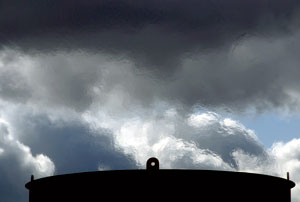The Flathead County landfill is a slowly growing mountain. Surrounding it, wells collect methane gas that funnels down to a tall, silo-like structure where it’s burned off, or “flared.”
“We decided that since it’s being flared anyway, it makes good sense to put that in an engine and make electricity with it,” says Ross Holter, director of energy service for Flathead Electric Co-op.
FEC buys electricity from the Bonneville Power Administration generated from hydroelectric plants. By 2011 BPA will cap the amount of energy the co-op can purchase. Holter says they’re looking to diversify their energy sources to meet the Flathead’s growing need.
Jim Chilton, who manages the landfill, gestures to several silver, corrugated metal wells located along the periphery of the landfill and draws a line through the air mapping out how they channel the gas down to the flare.
“Everything is piped down in one header pipe – you see where the gas – you see the flare stack? You see how there’s heat coming off it?” Chilton pointed to the tall cylindrical structure, fenced off at the bottom of the hill. No flame is visible, but the heat emanates in waves. Inside the silo are several ceramic nozzles where the gas comes out, burning.
“It’s a win-win for both places; for us and for Flathead Electric. Because now, we’re creating a product – methane – that is derived by rotting garbage,” Chilton explains. “Now we don’t have to burn it off into the atmosphere and we can do something useful with it and create power.”
Channeling methane gas from garbage to energy isn’t new technology, but this marks the first effort in Montana. Chilton says the methane will go into a new generator FEC will install.
“Instead of like a combustible engine that uses diesel fuel, this will be fired by methane,” Chilston says. “And, in turn, the pistons will turn the gas into power. It will put electricity into the grid.”
 |
|
Waves of heat curl out the top of the Flathead County landfill flare where methane is burned at 1,400 degrees. |
Chilton says the wells were originally installed because methane gas was seeping out from the landfill and contaminating the groundwater. The flare contains a “blower,” a type of fan creating a negative vacuum on the system that sucks the methane back and down to the flare.
Holter says FEC is planning to “turn some dirt” on the project in October, and start getting energy into the grid from the methane gas by spring. This differs from some of the other alternative energy programs contributing to FEC’s grid. Holter points out that the Flathead doesn’t have the wind resource of eastern Montana. There are some wind and solar projects here, he adds, but they affect individual households. If someone installs a solar panel creating enough energy to “roll back the meter,” they accumulate credit with the co-op, which they can cash in when their panel stops churning out energy.
But the cheapest and fastest way to bring down power bills is to improve efficiency.
“It pencils out a lot quicker to upgrade your attic insulation, or convert to compact fluorescent bulbs, or unplug that beer fridge out in the garage, or do any little things like that that you can do to save energy,” says Holter. “It makes 10 times more sense, 100 times more sense, than putting in your own energy production system.”
FEC is also teaming up with F.H. Stoltze Land and Lumber Co. to explore using biomass for heating fuel. This and other options are under consideration as the Flathead’s electricity demands grow.
“As our load grows, we’re going to have an increasing proportion of electricity that we have to find from other sources,” Holter says. “And energy efficiency we have factored in as a big part of that. So the more we can avoid needing, the less power we have to go buy.”
The co-op secured money for the methane project through “Clean Renewable Energy Bonds” totaling $3.5 million at a zero-percent interest rate. President Bush signed the CREB program into law in 2005 as part of the Energy Policy Act, a financial incentive for consumer-owned utilities and other eligible entities to pursue renewable energy resources. According to the IRS Web site, 367 projects were approved for 2008 at a total of $728 million. Of these, 41 were landfill gas facilities.
Holter says most landfills in Montana aren’t big enough to support this system, and even the Flathead landfill’s size will keep this project small. FEC intends to start with one generator able to produce 900 kilowatts, and will expand to produce 1.6 megawatts – enough electricity to power up to 1,600 homes, out of about 50,000 customers.